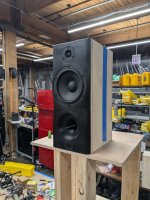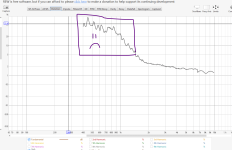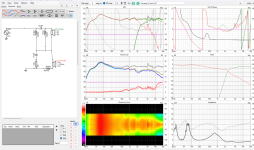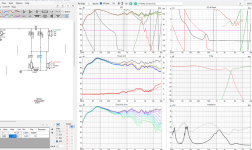This is my first series crossover so I would like someone to sanity check my work.
Background info and disclaimer:
1. Yes, I do know these are bass heavy. This whole build is made around some leftover Silver Flute woofers I had laying around. It is what it is.
2. In order to match the sensitivity of the woofer I needed a low impendence tweeter which forced me to series crossover. I can do it parallel and get to 3 ohm but that will still require a dedicated amp for this build which I am trying to avoid.
3. This by no means needs to be a perfect build. As long as it sounds ok I'm fine with it. It will be much better than the crappy sound bar that is currently at the family lake house.
4. The tweeter is utter crap below 2khz.
5. The woofer has a stupid breakup node at 5100 hz and I just cannot seem to get rid of it with a series crossover
6. This is all measured data.
Background info and disclaimer:
1. Yes, I do know these are bass heavy. This whole build is made around some leftover Silver Flute woofers I had laying around. It is what it is.
2. In order to match the sensitivity of the woofer I needed a low impendence tweeter which forced me to series crossover. I can do it parallel and get to 3 ohm but that will still require a dedicated amp for this build which I am trying to avoid.
3. This by no means needs to be a perfect build. As long as it sounds ok I'm fine with it. It will be much better than the crappy sound bar that is currently at the family lake house.
4. The tweeter is utter crap below 2khz.
5. The woofer has a stupid breakup node at 5100 hz and I just cannot seem to get rid of it with a series crossover
6. This is all measured data.
Attachments
I don't see any reason you are forced to use a series crossover. Here is a parallel crossover that I quickly mocked up with Xsim. The key to any crossover design is to start by compensating the impedance of each driver so that it is flat with frequency. If this isn't done first the rise in driver impedance negates any crossover filter effect. The RC network on the woofer is critical here as it keeps the impedance the same with rising frequency. The network on the tweeter is an example to flatten the rise with the tweeter low frequency resonance. It likely isn't needed in this design, but I left it in as an example.
Adding those parts will likely also help with a series network design. After adding compensation, I had no problem getting the parallel crossover to work just fine. The series 1 ohm resistor makes for a consistent 4 ohm speaker impedance.
The tweeter measurements are particularly bad looking. Typically tweeters have a much higher sensitivity than any woofer.



Adding those parts will likely also help with a series network design. After adding compensation, I had no problem getting the parallel crossover to work just fine. The series 1 ohm resistor makes for a consistent 4 ohm speaker impedance.
The tweeter measurements are particularly bad looking. Typically tweeters have a much higher sensitivity than any woofer.
Is this the tweeter? Peerless DX20BF00-04 3/4" Silk Dome Tweeter 4 Ohm. I attached the .frd for the DX20BF00 below.

The sensitivity of this tweeter is much higher than the .frd included in your files.

https://www.parts-express.com/pedocs/specs/264-1472--tymphany-dx20bf00-04-spec-sheet.pdf
The sensitivity of this tweeter is much higher than the .frd included in your files.
https://www.parts-express.com/pedocs/specs/264-1472--tymphany-dx20bf00-04-spec-sheet.pdf
Attachments
Last edited:
I'm the wrong person to offer any advice, being rather new to this... but...
Here's my version of your crossover.

- You don't have any Zoffset and based on your pic - there's at least 15mm where the Tdome is ahead of Wcone - so I'd add that.
- I'm not sure anything can be done about that 5K bump without a different kind of crossover; but even as is - it's a fairly narrow bump. It might be forgivable to the ear.
- I'd be more concerned about that 75Hz mountain.
Here's my version of your crossover.
If you want/need to keep the tweeter up where you currently have it, you need to make the rolloff on the woofer a bit steeper (try 2nd order but might likely need 3rd). Usually the breakup needs to be at least 15 or 20 (or more) dB below the summation. Also, polarity of drivers sometimes needs to be changed when increasing order of crossover.This is my first series crossover so I would like someone to sanity check my work.
4. The tweeter is utter crap below 2khz.
5. The woofer has a stupid breakup node at 5100 hz and I just cannot seem to get rid of it with a series crossover
One thing to keep in mind with a series xover is the inter-dependence of the components in adjoining branches. If you add or adjust values on the woofer branch, you'll likely need to adjust things on the tweeter branch as well. Parallel xovers not so much.
Z offset is baked in when measurements are taken with a reference. I aligned the z offset using the baffleI'm the wrong person to offer any advice, being rather new to this... but...
- You don't have any Zoffset and based on your pic - there's at least 15mm where the Tdome is ahead of Wcone - so I'd add that.
- I'm not sure anything can be done about that 5K bump without a different kind of crossover; but even as is - it's a fairly narrow bump. It might be forgivable to the ear.
- I'd be more concerned about that 75Hz mountain.
Here's my version of your crossover.
View attachment 1359539
Well, this is how it measured. I didn't calibrate the SPL so ignore the SPL. How it is relative to the silver flute is a real life meausrment so it is what it isIs this the tweeter? Peerless DX20BF00-04 3/4" Silk Dome Tweeter 4 Ohm. I attached the .frd for the DX20BF00 below.
View attachment 1359524
The sensitivity of this tweeter is much higher than the .frd included in your files.
View attachment 1359522
https://www.parts-express.com/pedocs/specs/264-1472--tymphany-dx20bf00-04-spec-sheet.pdf
I see. I pulled up the data on the Silver Flute and it is unusually sensitive at 93 dB! So that tweeter with 90 dB sensitivity at the crossover point will just give you a 3dB roll off in that area unless you do something to pad the woofer down a bit.
Using your measurement is the way to go. When I saw the magnitude response of upper frequencies of your tweeter response go way up I thought there might have been something wrong. It could be a sample rate conversion or something that doesn't matter.
Dave R. is the master of series crossovers, so I'm sure he can fix you up if you want to go that way.
Using your measurement is the way to go. When I saw the magnitude response of upper frequencies of your tweeter response go way up I thought there might have been something wrong. It could be a sample rate conversion or something that doesn't matter.
Dave R. is the master of series crossovers, so I'm sure he can fix you up if you want to go that way.
Olsond,
I did see you had that huge rise in FR after 20k. That is a glitch of some kind.
Yes, this driver may as well be a pro woofer with its sensitivity. It can also hit incredibly low in a small ported box. Its distortion is very low. The impulse is amazing. For $35, I know of nothing that can beat this thing. Originally I was going to chuck it into my car but it would not fit. It sure is an oddball.
I did manage to get a parallel to go over 4 ohm though it took more than double the amount of components than the series XO. It also isn't as well behaved. Series XO are definitely challenging.
I did see you had that huge rise in FR after 20k. That is a glitch of some kind.
Yes, this driver may as well be a pro woofer with its sensitivity. It can also hit incredibly low in a small ported box. Its distortion is very low. The impulse is amazing. For $35, I know of nothing that can beat this thing. Originally I was going to chuck it into my car but it would not fit. It sure is an oddball.
I did manage to get a parallel to go over 4 ohm though it took more than double the amount of components than the series XO. It also isn't as well behaved. Series XO are definitely challenging.
You should try to measure your tweeter lower. It looks like you cut off the sweep pretty high and either REW or VituixCAD is assuming a shallow roll off that isn't accurate. I measured that tweeter (in a much smaller cabinet) and probably started my sweep around 400 or 600Hz and this is what I got. Compare that to your raw tweeter frd.

Also, check your VituixCAD options and set Listening Distance to 2000mm if you have it set to 1000mm.
A4e,
Your crossover looks really good. I started messing with 3rd order series. If I can't get it to work I'll just chuck yours in.
I wantes to measure it lower but the thing sounded like it was going to tear itself apart. 25% distortion at 800 Hz. I didn't want to blow it up.
I have listening distance set to 2300mm
Your crossover looks really good. I started messing with 3rd order series. If I can't get it to work I'll just chuck yours in.
I wantes to measure it lower but the thing sounded like it was going to tear itself apart. 25% distortion at 800 Hz. I didn't want to blow it up.
I have listening distance set to 2300mm
Ok, I think I'm done now. This tweeter really sucks. See "sad face" around the horrendous distorion.
I took huge pains to cross this thing as steeply as possible without adding a million components in. Even a small amount of SPL from the tweeter beyond 1k would distort the mid range. I guess it would be useful if you had an active crossover but with passive.... this tweeter is not the move.
3.2 minimum impendence but a total system nominal impendence above 4 ohm.
I have learned how important it is to choose your drivers wisely rather than making do with leftover speakers. I managed to squeak by with this one.
I took huge pains to cross this thing as steeply as possible without adding a million components in. Even a small amount of SPL from the tweeter beyond 1k would distort the mid range. I guess it would be useful if you had an active crossover but with passive.... this tweeter is not the move.
3.2 minimum impendence but a total system nominal impendence above 4 ohm.
I have learned how important it is to choose your drivers wisely rather than making do with leftover speakers. I managed to squeak by with this one.
Attachments
The measurements you have posted in #15, could you please explain how took them, with or without Xover and at what power?
Your series crossover or the parallel Xover should be attenuating that *lLower end performance very quickly, at least 12dB/octave. you can change that rate in your VituixCad simulation quite easily by changing a component value and getting the roll of even stepper. The tweeter is not the most expensive, but if worked with can give reasonable results.
Your series crossover or the parallel Xover should be attenuating that *lLower end performance very quickly, at least 12dB/octave. you can change that rate in your VituixCad simulation quite easily by changing a component value and getting the roll of even stepper. The tweeter is not the most expensive, but if worked with can give reasonable results.
The measurements were all taken with a calibrated XLR mic using loop back as a reference. They were taken raw, no XO components at about 75db. Not exactly sure how much power the little Amp was pushing but I doubt it was very much since it's only capable of 30 watts itself
Thank you for the update. I still believe when used above 3KHz and with sensible Xover slope, third order say you shouldn't be getting the extreme distortion you have measured.
The energy levels in music are dropping off fast once beyond 1KHz and the tweeter is likely to see a lot less power than the woofer.
Maybe measure distortion again at 1 or 2 watts with the crossover in place and see what you get then.
Doing it with your series Xover is a bit trickier as the woofer/midrange leg is part of the Xover. VituixCad would let you simulate if you mute the woofer and then you can compare the parallel tweeter solution with the series solution in terms of response shapes.
The energy levels in music are dropping off fast once beyond 1KHz and the tweeter is likely to see a lot less power than the woofer.
Maybe measure distortion again at 1 or 2 watts with the crossover in place and see what you get then.
Doing it with your series Xover is a bit trickier as the woofer/midrange leg is part of the Xover. VituixCad would let you simulate if you mute the woofer and then you can compare the parallel tweeter solution with the series solution in terms of response shapes.
Raymond,
Here is 3rd order on the woofer as well. Now its super steep on either side.
I think the reason for the distortion is the tiny amount of xmax this tweeter has. I believe it is under 1mm.
I try to take my measurements pretty loud since there is normally some footsteps from the yoga studio above me leaking into my measurements.
This is a $45 crossover. $18 tweeter. $36 woofer. All in at around $150. I would say this is getting my money's worth. The idea behind this project was to see what could be done with minimal money that the average in my age bracket would want out of a small system.
Here is 3rd order on the woofer as well. Now its super steep on either side.
I think the reason for the distortion is the tiny amount of xmax this tweeter has. I believe it is under 1mm.
I try to take my measurements pretty loud since there is normally some footsteps from the yoga studio above me leaking into my measurements.
This is a $45 crossover. $18 tweeter. $36 woofer. All in at around $150. I would say this is getting my money's worth. The idea behind this project was to see what could be done with minimal money that the average in my age bracket would want out of a small system.
Attachments
- Home
- Loudspeakers
- Multi-Way
- Series Crossover - Sanity Check





